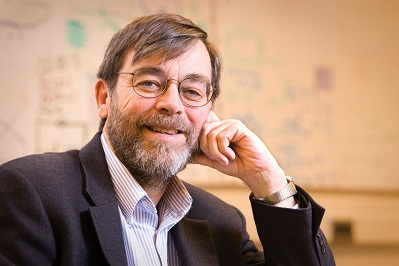A Student of Nature's Forces
Wednesday, December 8, 2010

Gary Lawson portrait
Shelly Elizondo got more than an expert background in nanotubes and computational methods for materials from her thesis adviser, Regents Professor and physicist John Mintmire. He inspired the future Raytheon engineer to think creatively in physics and communicate her ideas.
“He taught me how to communicate well — writing publications, preparing posters and slides for presentations, helping with grant proposals and delivering effective presentations,” says Elizondo, who works in advanced infrared imaging for military use. “He had many tips and tricks that I have often kept for myself over the years.”
An expert in computational physics, Mintmire is one of the three College of Arts and Sciences’ faculty members OSU named Regents Professor in 2009.
He began his career nearly 30 years ago as a theorist at the U.S. Naval Research Laboratory. There the University of Florida alumnus cut his teeth modeling carbon nanotubes and electroactive polymers (special compounds that conduct electricity) in the laboratory’s chemistry division.
“Our computational simulations and related theoretical work stimulated a large group of experimentalists who were trying to make these carbon nanotubes in pure form to test whether they were really conducting,” Mintmire says. “With devices, we have hit a limit as far as performance goes. You can see this in the increasing number of cores in computers. The limits in switching speeds for processors in PCs are pushing us toward other avenues for improved computational performance.”
Mintmire, an avowed science fiction lover, began his fascination with physics when he was a kid growing up in rural Russell Springs, Ky., and read his older brother’s college physics textbook.
“I was fascinated with the math and understanding the forces of nature. I think most physicists are attracted to that. Essentially, a lot of us tend to be problem solvers, more interested in things we have to figure out. I must have been seven to nine years old when I read it.”
He also remembers a math teacher in high school who used to take him to the local junior college where he learned about computer programming using the college’s early accounting mainframe computer, typing in his input using punch cards.
He graduated from the University of Florida with his doctoral degree in 1980 before beginning his postdoctoral work at the Navy’s corporate research laboratory. In 2001, he came to OSU for the opportunity to work with students and develop a thriving physics department.
Accepting a department head position at OSU, Mintmire became the College of Arts and Sciences associate dean of research two years later. He spent five years as an administrator, but these days he prefers teaching and working with his computational materials physics research group.
Last January, he finished a grant from the Department of Energy to study nanostructures (objects somewhere between atomic and microscopic in size) and is now finishing a Department of Defense grant to develop nanoscale models of ionic materials.
He has published more than 100 journal articles and other publications, as well as given presentations from Washington, D.C., to Saint Petersburg, Russia. He is on the editorial boards of the International Journal of Quantum Chemistry and Advances in Quantum Chemistry and is a Fellow of the American Physical Society and the International Union of Pure & Applied Chemistry. He received a University of Florida Outstanding Alumni Award and was a finalist in 2000 for the Foresight Institute’s Feynman Award in Nanotechnology.
This story originally ran in the 2010 College of Arts & Sciences magazine.
